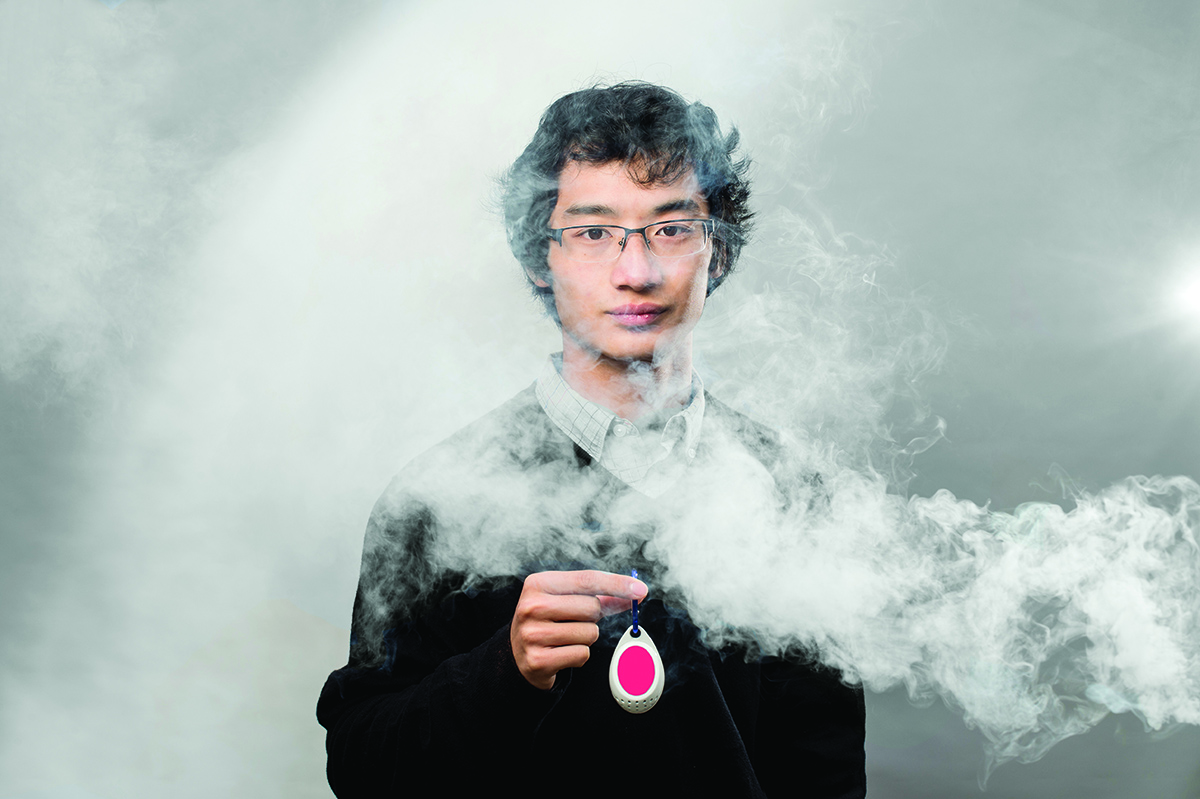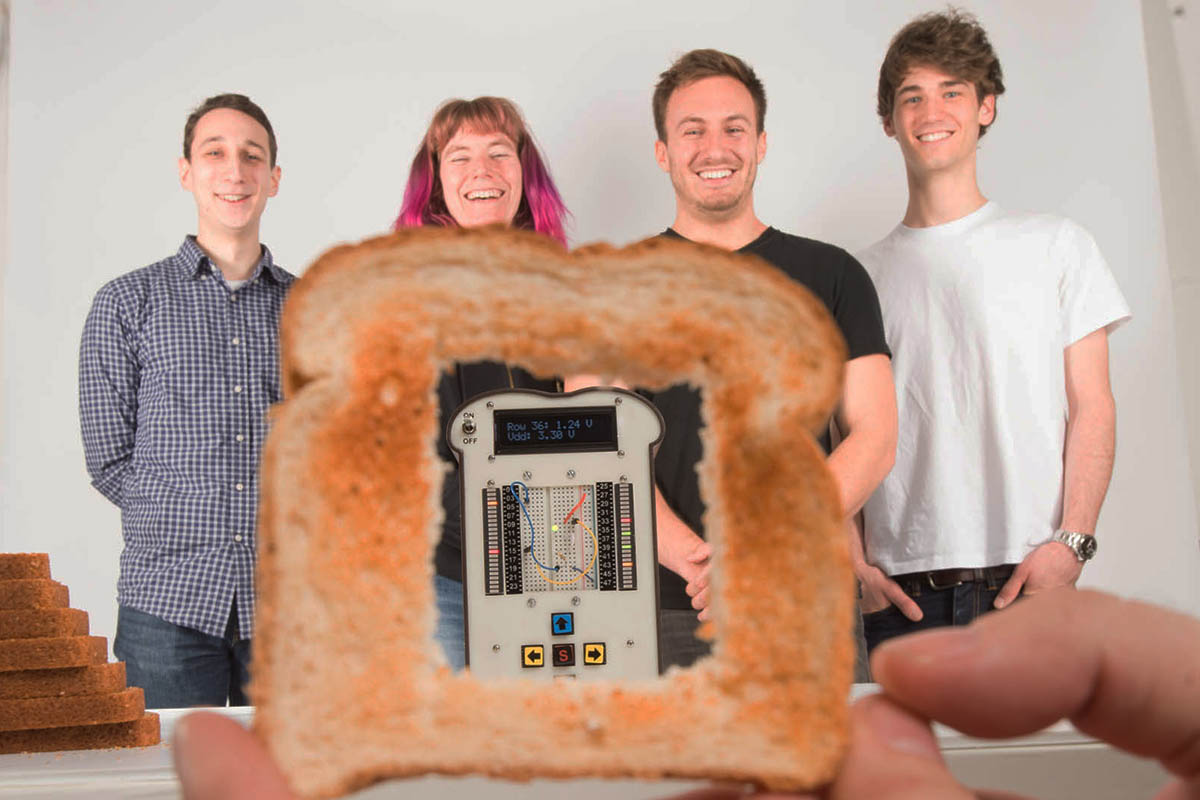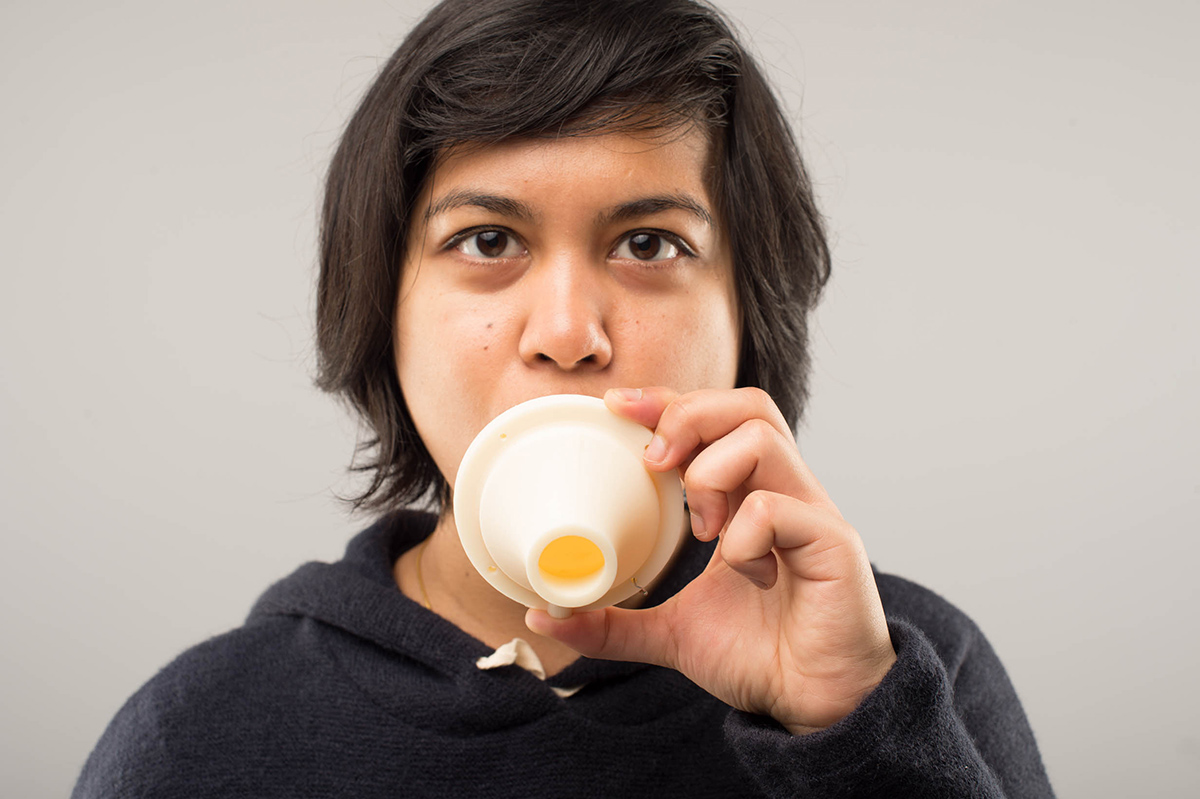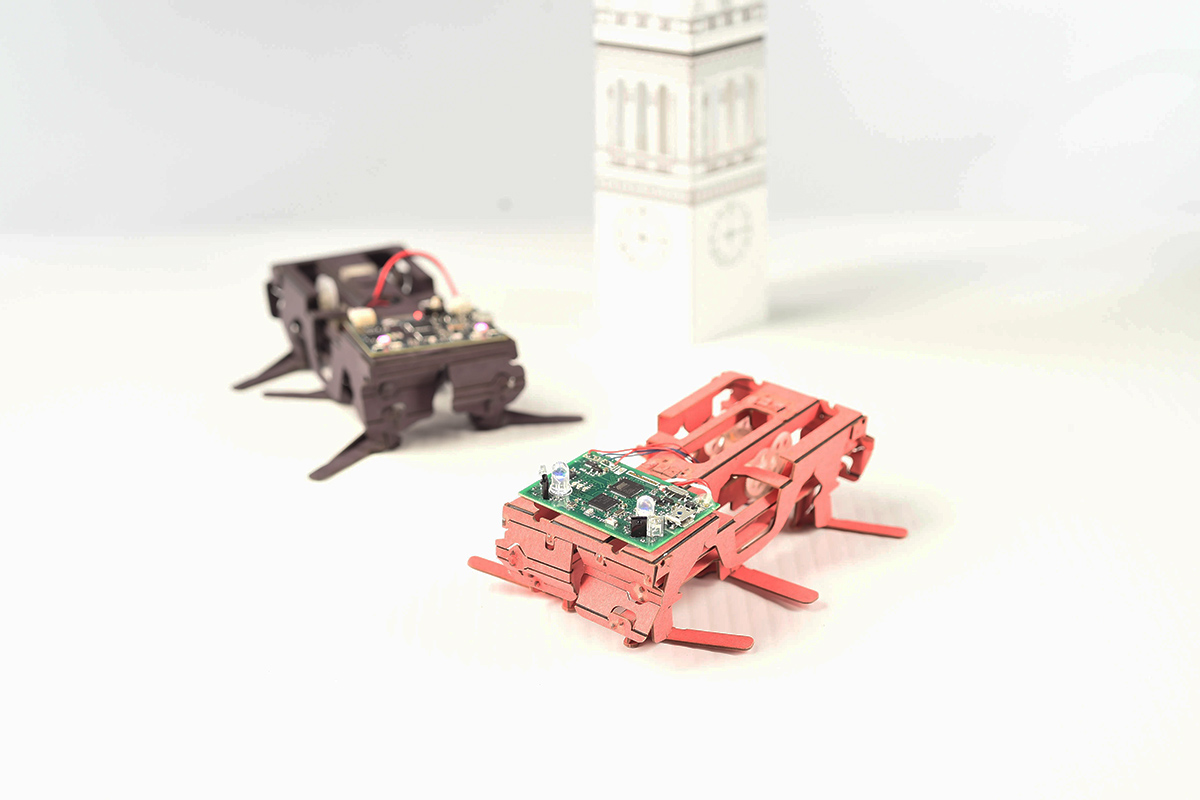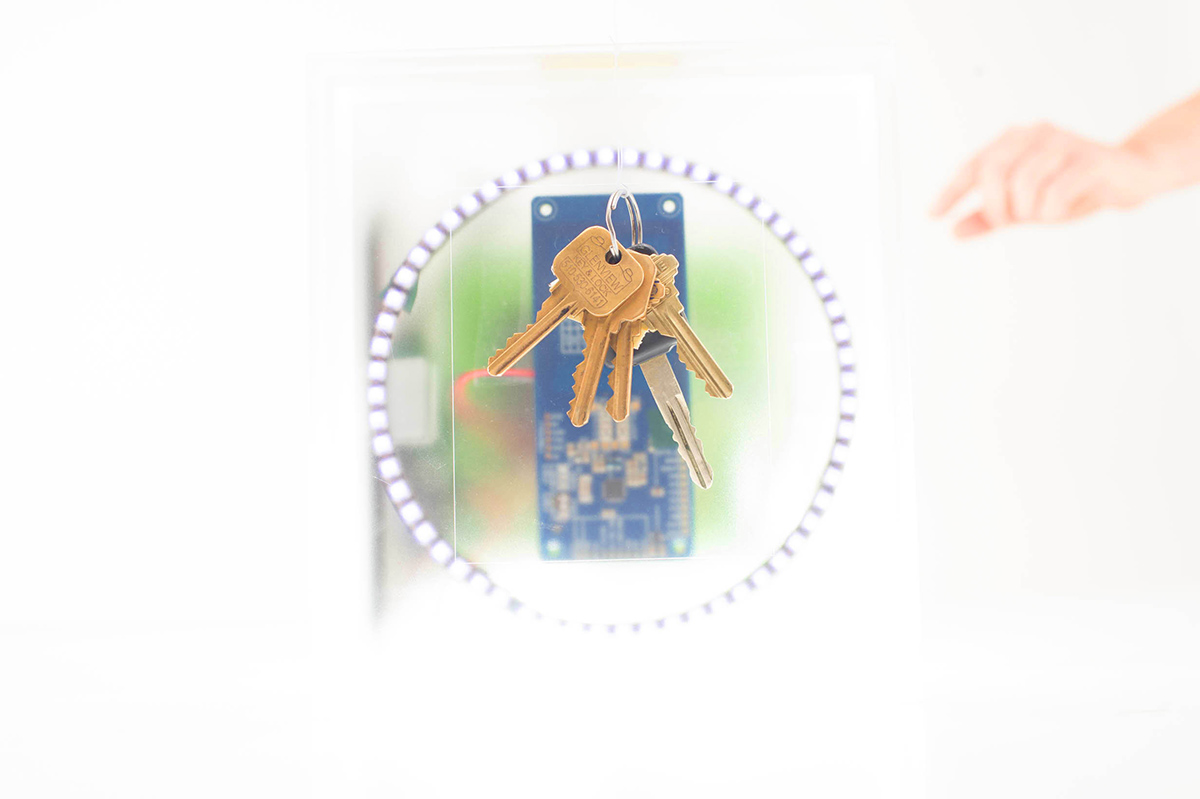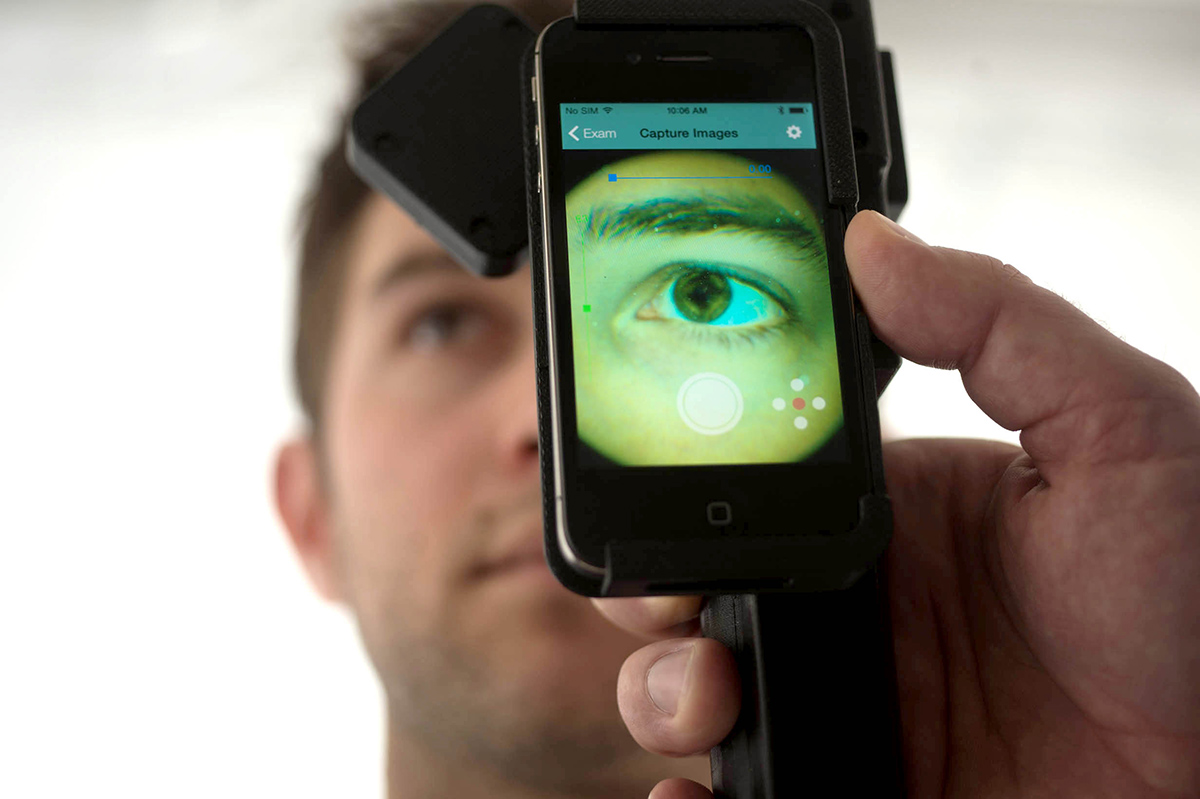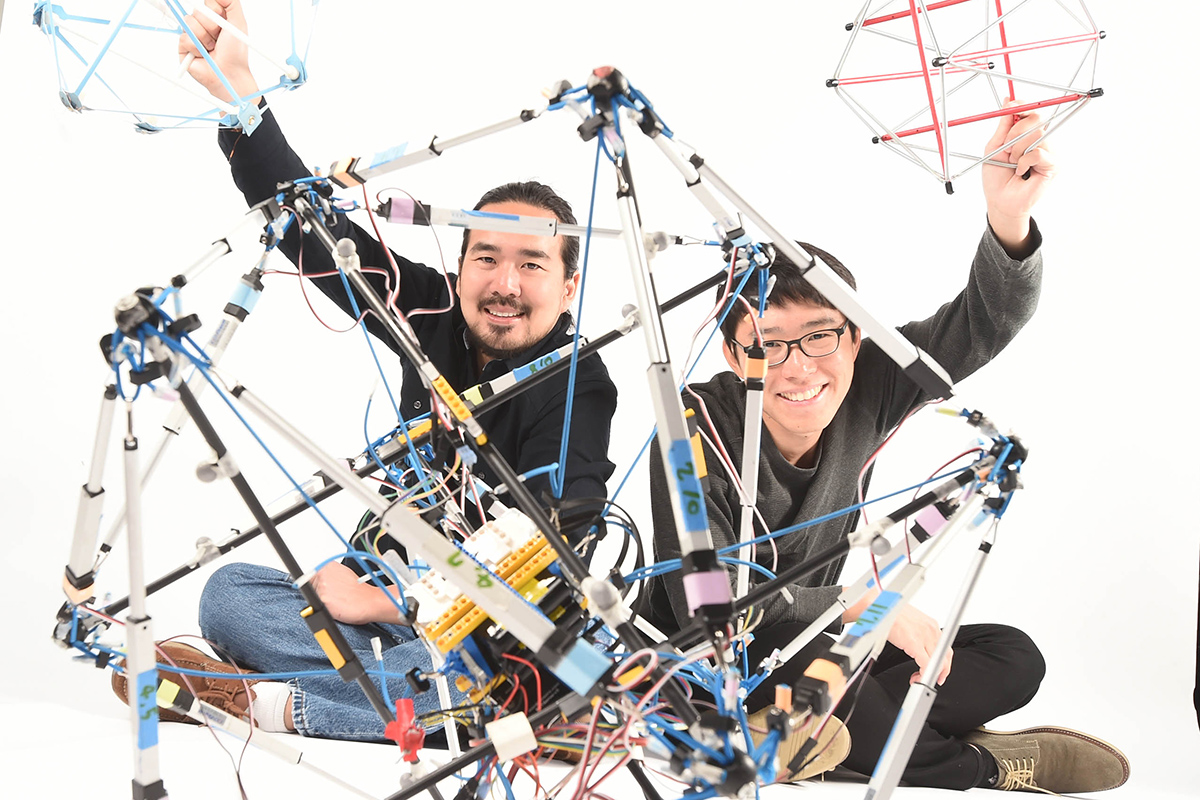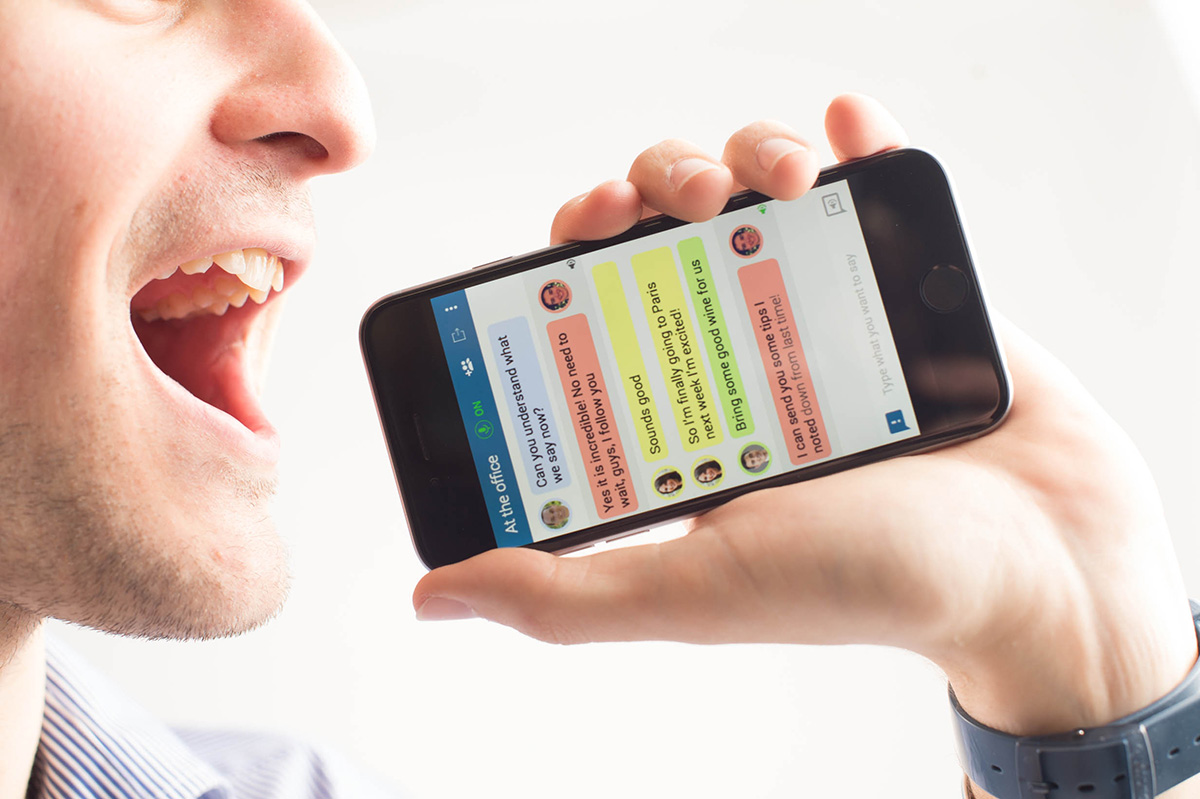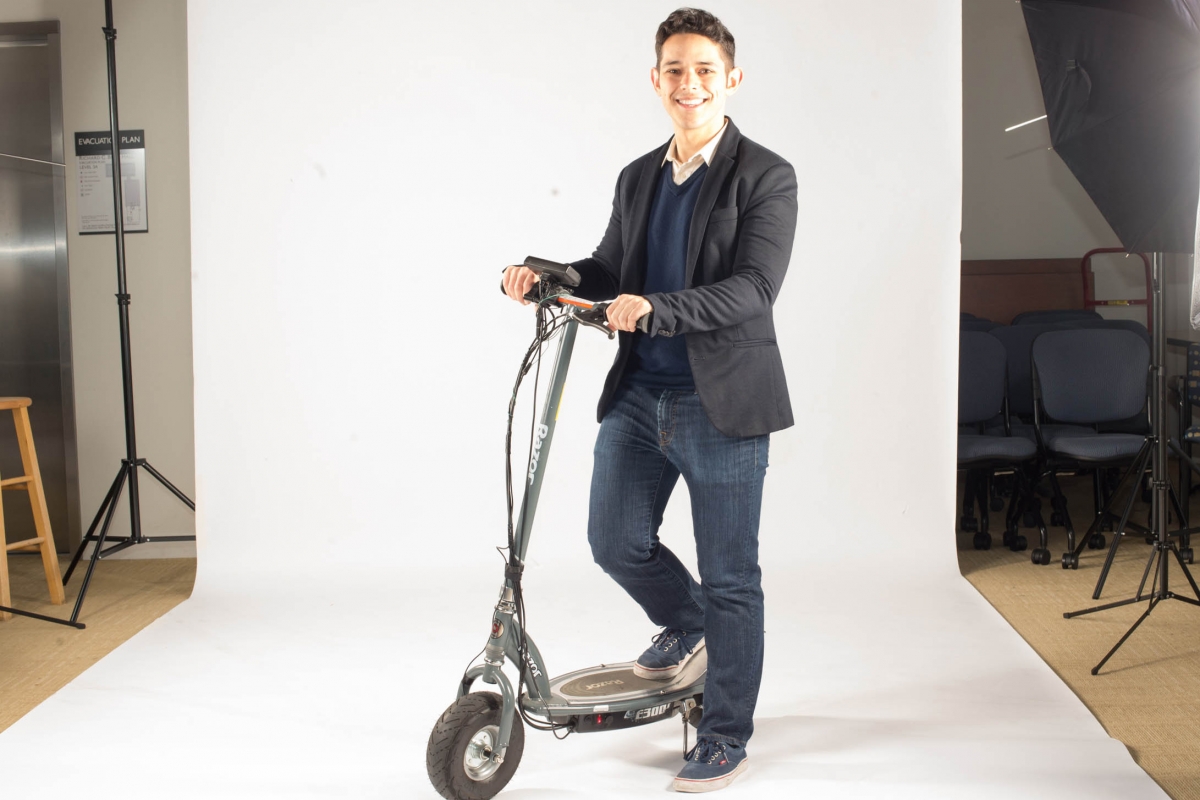In the domain of design

Björn Hartmann is always on the move, but one good place to find him is at the CITRIS Invention Lab, which he co-founded with mechanical engineering professor Paul Wright and co-directs with fellow electrical engineering and computer sciences professor Eric Paulos. In the big, open workspace in Sutardja Dai Hall, students are constantly rearranging benches, tool racks, parts cabinets and other paraphernalia. Everything needed for a design team to plan and prototype — and prototype again and again — is close at hand.
“The vision of the Invention Lab is to have high-value digital fabrication tools and to make them available to anyone,” says Hartmann — one reason why the Invention Lab is available to all Berkeley students and staff. “The most interesting work happens in collaborations.”
Hartmann grew up a native of the digital age. Born near Heidelberg in 1978, when personal computers were being introduced, he has used computers in everything he has done, especially music.
“There was a small annex in our house used by a music school, where I learned to play the piano in jazz combos,” he says. “Before there was an Internet, we used bulletin board systems, and people would dial in and leave messages. I became part of a music group that existed only virtually; it probably took us a year before we met in person.”
While still a teenager, he gained a reputation as an avant-garde composer and DJ, using PCs to create music. These dual enthusiasms made for a winding path to an academic career. Even after receiving bachelor’s and master’s degrees in digital media and computer science from the University of Pennsylvania and studying human-computer interaction in Paris and Rome, Hartmann was undecided between a career in research or music.
Music won the first round. He moved to Amsterdam in 2002 and co-founded Contexterrior Media, managing a clutch of record labels and performing as a recording artist and DJ on tours of Europe and Japan. The experience was creatively fulfilling, but he ran into an unexpected problem: success.
“If you’re successful in business, the incentives are to do more of the same,” he says. By contrast, “At a university, the freedom to explore is part of the job description.”
Hartmann returned to research, putting all of his experience to use. “Running a startup company, and believing that with tenaciousness you can see it through, was immensely helpful for my research afterwards.” He received his Ph.D. in computer science at Stanford in 2009 with work on user interface design, and joined the Berkeley Engineering faculty shortly thereafter.
Last spring, the college named Hartmann chief technology officer for the Jacobs Institute for Design Innovation, launched in 2013; anticipating the fall 2015 opening of the institute’s new headquarters, Jacobs Hall, Hartmann is poised to help drive the next stage of the digital revolution.
As the institute’s name suggests, it’s all about design. Ask Hartmann what design means, and he quotes Herbert Simon, the polymath and Nobel Prize-winner in economics: “Everyone designs who devises courses of action aimed at changing existing situations into preferred ones.”
Simon made the remark in 1968, when design education at even the best engineering schools was under threat from a nationwide shift favoring the natural sciences. Design is the core of all professional training, Simon argued, whether the subject is medical treatment, a business sales plan or the social policies of government. Radical at the time, his view gained traction in the late ’70s. Now business, government, the arts and education have all embraced “design thinking.”

 Prototype | Vires Aero
Prototype | Vires Aero
Design team | Harshil Goel / Zachary Hargreaves / Jordan Greene
Design for the Internet of Things
Engineers wearing their design hats have always sought to match technology and human needs, Hartmann says, because “the domain of design — what can be designed and what should be designed — changes when the technology landscape changes.”
He cites two classic furniture designs. In the 1920s, Marcel Breuer’s Bauhaus chairs were inspired by the introduction of seamless tubular steel; in the 1940s, Charles and Ray Eames used their own plywood molding process to make a revolutionary wooden lounge chair. Exploring the aesthetics of novel technologies, both chairs achieved surprising beauty.
Motivated by the Breuer and Eames chairs, this spring the Jacobs Institute offered a class on Interactive Seating, taught by an interdisciplinary team headed by Hartmann and including professor of art practice Greg Niemeyer (also director of the Berkeley Center for New Media) and Robert Full, professor of integrative biology. Student designs for “smart chairs,” with built-in new technologies to provide benefits such as feedback on posture, will be presented at the opening of Jacobs Hall.
It’s no longer surprising to find computers built into something to sit on (or possibly fall asleep in). “Sensors and actuators and computation are moving everywhere into objects in the environment,” says Hartmann, “into the age of ubiquitous computing, the Internet of Things.”
The prospect, reaching far beyond furniture, sparks both excitement and fear. Devices vacuum up information to keep track of your keys and money, monitor your health — or steal your identity. With do-it-yourself tools, you can make everything from smart toys to automatic weapons. “As the technology landscape changes, it changes how we live our lives,” says Hartmann. “How should one design applications and products for a future where everyday objects have computing power built in?” The question is at the heart of human-centered design.
 Prototype | KNOX Diagnostics
Prototype | KNOX Diagnostics
Design team | Charvi Shetty / Huyson Lam / Inderjit Jutla
“What’s essential is to step back and ask, ‘What does society need?’ You have to stay decoupled from the solution until you’ve figured out the problem.”
— Amy Herr
In his Interactive Device Design course, co-taught with Wright in the Invention Lab, Hartmann poses the question directly to students from engineering, business, art, cognitive science and other disciplines. They team up to create devices specifically designed to respond to their users.
Well-stocked with components like Arduino microcontrollers and Raspberry Pi microcomputers, the lab is equipped with advanced machinery. “More and more fabrication tools are now entirely software-driven, for example 3-D printers and laser cutters,” Hartmann says. “So if you have the right machines and put in the time to create a 3-D representation of the object you want to build, the machine does the rest.”
Students hone their skills by examining the design process from consumer research to finished prototype. Teams who want to try starting a business with a promising new gadget are eligible for fellowships, grants and workspace.
The Invention Lab, along with other facilities like the Cal Design Lab in the College of Environmental Design and the Haas School of Business Innovation Lab, exemplifies a new teaching style, with professors as “guides on the side” to help students as needed; in the Invention Lab, professional technicians are on hand with supplies and useful advice.
Hartmann calls this kind of facility and the education it makes possible a “workable model to grow in the Jacobs Institute” when Jacobs Hall opens. “But the Jacobs Institute has a larger mission, to which the fantastic faculty will bring their own expertise.”
 Prototype | Clarity
Prototype | Clarity
Design team | David Lu / Deepak Talwar / Hannah Hagen / Baljot Singh
‘Wicked problems’
One faculty member is professor of mechanical engineering Alice Agogino, who will teach her classic course in Introduction to Product Development to a hundred students this fall in Jacobs Hall’s largest studio. Agogino introduced the concept of design thinking to the College of Engineering shortly after she came to Berkeley in 1984 — years before the term itself had entered the language.
She recalls being asked to create a seminar in design theory and methods and reaching out to “the inquiry disciplines, the creative arts, rhetoric,” and many other departments across the campus. “It was the intellectual foundations of how they framed design that I wanted to understand, where they intersected. What could we learn from each other?”
Among those whose ideas impressed her was Horst Rittel, a professor in the College of Environmental Design. In 1973, Rittel had introduced the term “wicked” to describe certain problems, the very nature of which makes them hard to define, much less to solve creatively and effectively.
Some design problems are tame (tame problems have rules and unambiguous resolutions, like a game of checkers); Agogino says they’re routine and can often be handled by automation. “Designers should be working on the hardest problems, the wicked problems.”
 Prototype | Smart scooter
Prototype | Smart scooter
Design course | CE 186: Design of Cyber-Physical Systems
“We’re doing our best to create a little test bed in which the students can iterate. They learn to program an Arduino microcontroller on an electric scooter and ride around campus and collect data on their own mobility patterns.”
— Scott Moura
Rittel called design “an argumentative process,” says Agogino. “He said that when you talk to your customers and other designers and different stakeholders, you’re always making tradeoffs, and you have to understand what they are. To do this you need a deep, empathetic understanding of customers’ and users’ needs.” She adds, “It looks like what today we call design thinking.”
Another design thinker Agogino met early on was Sara Beckman, a senior lecturer at the Haas School of Business and an industrial engineer by training and experience. The two of them created a course in developing new products that is still going strong 20 years later. The course led to an emerging awareness of an underappreciated component of successful design: team diversity.
Academic and industrial studies have shown the practical worth of technical expertise, gender, ethnicity, age, socio-economic status and other kinds of diversity in many kinds of teams. David Kolb of Case Western Reserve identified a different kind of diversity: how people learn. He graphed how we perceive information on a central vertical axis, with abstract thinking at the top and concrete experience at the bottom. How we process information he plotted horizontally from left to right, with reflective observation at one extreme, active experiment at the other.
In a 2007 journal article, Beckman and innovation consultant Michael Barry codified how learning styles affect the design process. Where abstract thinking and thoughtful observation overlap, the learning style is called “assimilation”; on a design team, these thinkers understand users’ problems readily and can suggest a variety of solutions.
Where abstract thinking combines with active experiment, “convergent” thinkers may take the problem as a given, propose a single solution and go straight to prototype.
In experiential territory, where active experiment overlaps with concrete experience, “accommodators” test prototypes repeatedly and use what they learn to improve the design. Agogino calls these the “makers” of the world.
“It’s tempting to think the design process proceeds in steps, but it’s a lot messier than that,” she says. “It’s not linear at all. It involves lots of iterations.”
 Prototype | ToastBoard
Prototype | ToastBoard
Design team | Filip Maksimovic / Julie Newcomb / Daniel Drew / Dominic Cincione
The point becomes clear in the graph’s final corner, where concrete experience overlaps thoughtful observation to result in “divergence.” It’s a rare style of learning about the world that can inform any stage of the design process; divergent thinkers have the off-the-wall ideas and unexpected insights into needs, solutions and even novel prototypes.
To quantify diversity’s effect on design team performance, Agogino, Beckman and mechanical engineering doctoral candidate Kimberly Lau studied 33 student teams, focusing on different learning styles, as well as gender, expertise and other factors.
After the teams were ranked, it was clear that no style is inherently better or worse than another at predicting team success. In fact, when one learning style is overrepresented — or one gender, or one kind of expertise — performance suffers.
The handicap is lack of diversity. For example, none of the four all-male teams or five all-female teams scored in the top quarter. The highest score was won by a team with three women and one man, who represented a range of learning styles: two were assimilators, one a convergent thinker and one an iteration-enthusiastic accommodator.
Agogino sees the Jacobs Institute as highlighting diversity and other key issues in a way never before achieved at Berkeley. “Design is multidisciplinary,” she says, “but it’s a struggle to cross departmental boundaries. I see the Jacobs Institute as unleashing the creativity that comes from building on and transcending disciplinary strengths.”
Dents in the universe
The Jacobs Institute is intended for undergraduates, and while many of them will be engineering majors, many others will come from the arts, humanities, business and social sciences. They’ll tackle specific projects in teams, ask many questions of potential users, get their hands on modern materials and high-tech machines and prototype their ideas repeatedly.
 Prototype | Transcense
Prototype | Transcense
Design team | Thibault Duchemin / Pieter Doevendans
To enable faculty members to take advantage of what Jacobs Hall will offer, Emily Rice, the institute’s director of programs and operations, runs a “mini-grant” program to underwrite new courses or revise existing ones to become more hands-on.
The challenge isn’t trivial. Rice taught a class in basic digital fabrication and was surprised to find her students had done little hands-on work. “Half of them had never used a drill before,” she says. “It showed me just how far we’ve gotten, culturally, from being comfortable even with hand tools.”
Computers, smartphones, tablets and apps (and television sets before them) may have seduced people into watching the world instead of handling it, but it’s a transitional phase that won’t last long. The makers are here. Close behind, a generation of do-it-yourselfers is growing up in a world where any device they can program can be fabricated and equipped with its own sensors, controllers, processors and communication. That’s why “hands-on” — the sine qua non for most Jacobs Institute classes — is only the beginning.
Bioengineering professor Amy Herr’s senior capstone Bioengineering Design Projects class focuses on novel instrumentation in medicine and basic biology. “What’s essential is to step back and ask, ‘What does society need?’ You have to stay decoupled from the solution until you’ve figured out the problem.”
Herr says her design classes start with “the what, not the how” — understanding the need before jumping to a solution. “For us, it’s understanding and quantifying what’s needed, performance-wise,” and that depends on the user. “A test for Lyme disease may need to measure two biomarkers, while a systems biology problem may require hundreds.”
Once there’s a possible solution, prototyping and iteration are vital. “Fail early, fail often, fail cheap,” Herr says. “If it isn’t going to work, we want to know quickly.”
 Prototype | Dash Robotics
Prototype | Dash Robotics
Design team | Paul Birkmeyer / Andrew Gillies / Nick Kohut
“The myth of art and design is that you have to be born with the trait to be an artist or a designer. I believe it is much more a process and skill that can be learned — and consequently that we can teach, to lots of people.”
— Björn Hartmann
Scott Moura, a professor of civil and environmental engineering, cautions that “in civil engineering, it’s a whole different game,” where full-scale iteration may be impossible.
The capstone course Moura teaches, Design of Cyber-Physical Systems, investigates ways to integrate electric vehicles with the electrical power grid. By 2020, with many more electric vehicles on the road and an accelerating shift toward electricity from renewable sources, the demand on traditional generators will spike dangerously after the sun goes down. “We cannot afford, as a society, to let the grid break,” he says, “and then try to rapidly iterate our way to a solution.”
Any likely fix involves changing people’s behaviors and attitudes toward their cars — an especially wicked problem. Brainstorming on the phone with his colleagues while in Paris, Moura came up with a bit of divergent thinking. “Walking around Paris, I’d see kids zipping around on Razor scooters. We couldn’t loan all our students a Volt, but maybe a $300 scooter…”
“What are we designing? Are we designing for those in extreme poverty? Are we designing for the human condition? I hope so, and I hope that becomes part of the Jacobs Institute story.”
— Alice Agogino
The course aims to test incentives for behavioral change. “We’re doing our best to create a little test bed in which the students can iterate. They learn to program an Arduino microcontroller on an electric scooter and ride around campus and collect data on their own mobility patterns,” says Moura. Routes, charge levels and other variables are stored in the cloud and used to calculate how different schemes affect different goals — minimal CO2 impact versus minimal cost.
“Reframing things creates new understanding,” says Eric Paulos, who looks forward to leading his Critical Making class in Jacobs Hall. “Constraints are your friends,” he says, adding that “design at its best is a critique, a transitional process that starts a debate into the different directions technology should go.”
These are crucial questions, says Alice Agogino. “What are we designing? For whom are we designing it?” Users are many, but “are we designing for those in extreme poverty? Are we designing for the human condition? I hope so, and I hope that becomes part of the Jacobs Institute story.”
For Björn Hartmann, the answers are personal. “Design has to be there from the beginning. The artifacts, the objects, the devices that really succeed in making a dent in the universe, they are what show concern for both technology and questions of human use. They have empathy with their users.”


